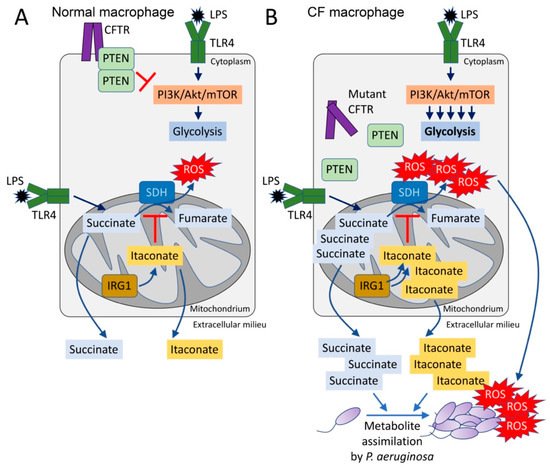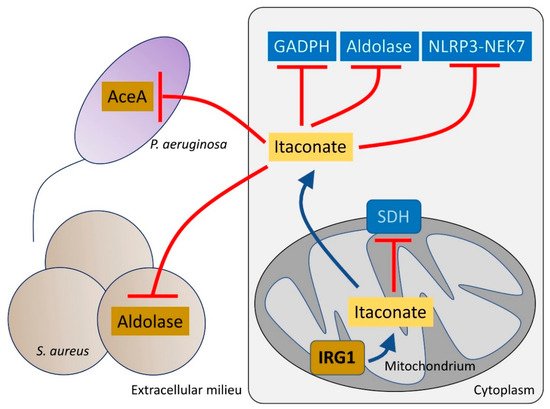Historically, bacteria have been classified by their metabolic activity which roughly correlates with the tissues that are major sites of infection
[11]. Directed by small RNAs and the
crc locus,
P. aeruginosa preferentially consumes succinate over other carbon sources until it is depleted, through a process named catabolite repression
[12][13][14][15][16]. Thus, in a setting replete with succinate, such as the inflamed airways,
P. aeruginosa would have a supply of a major carbon source. Of note, succinate is one of the major metabolites released by macrophages activated by lipopolysaccharide (LPS)
[17][18]. Activated macrophages undergo metabolic reprogramming, switching to generate ATP by aerobic glycolysis instead of oxidative phosphorylation (OXPHOS) pathways in the mitochondrion
[19]. This metabolic switch repurposes succinate oxidation in the mitochondria not to produce ATP, but, instead, to release bactericidal ROS by action of succinate dehydrogenase (SDH) (complex II) and isocitrate dehydrogenase (IDH, complex I)
[19] (
Figure 1A). Succinate influx into the active site of SDH is potentiated by anerplerosis, a biochemical process that favors both synthesis and accumulation of succinate from foreign metabolites, such as environmental glutamine
[18][19]. Thus, by activating an inflammatory response through LPS,
P. aeruginosa provides itself with a favored substrate, succinate (
Figure 1A). Even in the normal lung, activated macrophages produce and oxidize succinate, which stimulates both stabilization of the hypoxia-induced factor 1α (HIF-1α) and generation of the potent proinflammatory cytokine IL-1β
[17][18][19][20]. As described below, a greater production of succinate in cells with CFTR dysfunction may favor
P. aeruginosa proliferation
[21] (
Figure 1B). Thus, the CFTR dysfunction and excess proinflammatory signaling fuels
P. aeruginosa growth, possibly to a greater extent than the recruited immune cells can clear the organisms.
Figure 1. The CFTR-PTEN complex regulates macrophage metabolism and release of immunometabolites. (A) During LPS recognition by TLR4, macrophages activate PI3K-Akt-mTOR signaling and glycolysis. The CFTR-PTEN complex regulates this process by inhibiting PI3K function. In parallel, TLR4-LPS interaction promotes anerplerosis, which replenishes the host mitochondria with succinate. Succinate is oxidized by succinate dehydrogenase (SDH) to fumarate, which produces bactericidal ROS. Pro-oxidant SDH activity is regulated by IRG1, which produces itaconate that competes with succinate for the active site of SDH. (B) In the absence of the CFTR-PTEN complex, glycolysis is overactivated, as well as succinate oxidation. Itaconate is overproduced to compensate for succinate oxidation, leading to both succinate and itaconate accumulation in the mitochondria. Both metabolites are abundantly released out of the cell, where they can be assimilated by Pseudomonas aeruginosa. These organisms also sense ROS, which promotes adaptive changes like biofilm formation.


